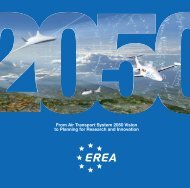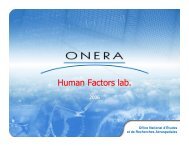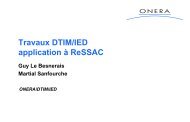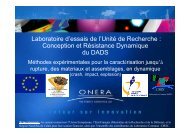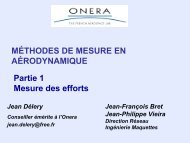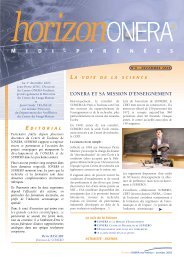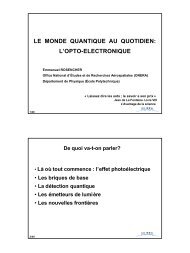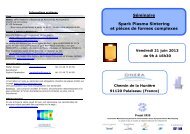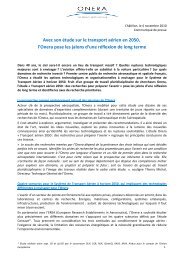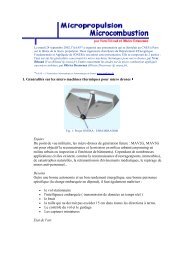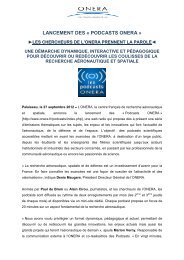Afterbody flows - Onera
Afterbody flows - Onera
Afterbody flows - Onera
Create successful ePaper yourself
Turn your PDF publications into a flip-book with our unique Google optimized e-Paper software.
<strong>Afterbody</strong> <strong>flows</strong><br />
H. Werlé. © <strong>Onera</strong>
<strong>Afterbody</strong> <strong>flows</strong><br />
1. Non-propelled afterbody<br />
2. Propelled afterbody without base<br />
3. Propelled afterbody with base<br />
4. Rectangular section afterbody<br />
5. Two-nozzle afterbody<br />
6. Flow past an automobile
Non-propelled axisymmetric afterbody at incidence<br />
Skin friction line pattern<br />
Body, side view Seen from above Seen from below<br />
Base<br />
Base at zero incidence
Non-propelled axisymmetric afterbody at incidence<br />
Skin friction line pattern<br />
On the base<br />
On the afterbody
Non-propelled axisymmetric afterbody at incidence<br />
Flow in the vertical symmetry plane
Non-propelled axisymmetric afterbody at incidence<br />
Detachment surface
Non-propelled axisymmetric afterbody at incidence<br />
Flow projected in a vertical downstream plane<br />
Improbable symmetric organisation<br />
More probable asymmetric organisation
Non-propelled axisymmetric afterbody at incidence<br />
Skin friction line pattern (upstream part developed)
Non-propelled axisymmetric afterbody at incidence<br />
Main detachment surfaces
Non-propelled axisymmetric afterbody at incidence<br />
Flow projected in a vertical downstream plane or wake structure
Propelled afterbody without base at incidence<br />
Skin friction line pattern and separation surface
Propelled afterbody without base at incidence<br />
Skin friction line pattern at nozzle exit<br />
Details at node N 1<br />
Detachment node<br />
Details at saddle point C 1
Propelled afterbody without base at incidence with jet pluming<br />
Skin friction line pattern on the fuselage and jet surface<br />
Symmetry plane and jet separation surface
Propelled afterbody without base and jet pluming<br />
Main detachment surfaces
Propelled afterbody with base at incidence<br />
Skin friction line pattern on the fuselage<br />
Seen from above<br />
Leeside<br />
Side view<br />
Seen from below<br />
Windward side
Propelled afterbody with a base<br />
Skin friction line pattern on the base
Propelled afterbody with base at incidence<br />
Skin friction lines on<br />
the afterbody<br />
Streamlines in the symmetry plane and on the jet separation surface
Propelled afterbody with base at incidence<br />
Attachment<br />
surface<br />
Detachment<br />
surface<br />
Jet separation<br />
surface<br />
Main separation surfaces
<strong>Afterbody</strong> with rectangular cross section<br />
Jet separation surface<br />
<strong>Afterbody</strong><br />
Trailing edge<br />
Skin friction line pattern on the suction side
<strong>Afterbody</strong> with rectangular cross section<br />
Jet separation<br />
surface<br />
Main separation surfaces
<strong>Afterbody</strong> of a twin-nozzle fighter aircraft<br />
Dassault Aviation Jaguar fighter aircraft
<strong>Afterbody</strong> of a twin-nozzle fighter aircraft<br />
Simplified afterbody geometry<br />
Fuselage<br />
Base<br />
Nozzle<br />
Nozzle
<strong>Afterbody</strong> of a twin-nozzle fighter aircraft<br />
Saddle point<br />
Wind tunnelS3Ch. © <strong>Onera</strong><br />
Surface flow visualization
<strong>Afterbody</strong> of a twin-nozzle fighter aircraft<br />
Skin friction line pattern
<strong>Afterbody</strong> of a twin-nozzle fighter aircraft<br />
Skin friction line pattern. Details at the nozzle lip<br />
Details in the vicinity of<br />
saddle point C 4
<strong>Afterbody</strong> of a twin-nozzle fighter aircraft<br />
Wind tunnel S3Ch. © <strong>Onera</strong><br />
Schlieren visualisation of the jets
<strong>Afterbody</strong> of a twin-nozzle fighter aircraft<br />
Flow in the symmetry planes<br />
Plane containing the nozzle axes<br />
Perpendicular plane
<strong>Afterbody</strong> of a twin-nozzle fighter aircraft<br />
(One half of the surface is drawn for clarity)<br />
Detachment surface attached to the afterbody extremity
<strong>Afterbody</strong> of a twin-nozzle fighter aircraft<br />
Details<br />
Details<br />
(Only one surface is represented)<br />
Detachment surface attached to the nozzle lip
<strong>Afterbody</strong> of a twin-nozzle fighter aircraft<br />
Representation of the main separation surfaces
<strong>Afterbody</strong> of a twin-nozzle fighter aircraft<br />
Traces of the jets<br />
Flow projected in a normal downstream plane
Aerospike type nozzle with 24 peripheral jets<br />
Jet exit<br />
Jet exit<br />
Wind tunnel R2Ch. © <strong>Onera</strong><br />
Surface flow visualisation
Aerospike type nozzle with 24 peripheral jets<br />
Jet exit<br />
Wind tunnel R2Ch. © <strong>Onera</strong><br />
Surface flow visualisation. Close up of the jet exit region
Aerospike type nozzle with vectoring lateral jet<br />
Surface flow visualisation<br />
Vectoring jet<br />
Wind tunnel R2Ch. © <strong>Onera</strong>
Aerospike type nozzle with vectoring lateral jet<br />
Wind tunnel R2Ch. © <strong>Onera</strong><br />
Surface flow visualisation. Lateral jet exit region
Aerospike type nozzle with lateral jet<br />
Skin friction line pattern<br />
Nozzle jet impacts<br />
Detachment induced by<br />
the lateral jet<br />
Lateral jet
Automobile<br />
H. Werlé. © <strong>Onera</strong><br />
Water tunnel visualisation of the flow past the Citroën DS21 car
Sedan type or three-box automobile<br />
Radiator<br />
grille<br />
Bonnet<br />
Windshield<br />
Passenger cell<br />
Roof<br />
Rear<br />
window<br />
A-pillar<br />
Side<br />
Boot<br />
Rear part
Sedan type or three-box automobile<br />
Seen from above<br />
Side view<br />
Front view<br />
Surface flow visualizations with viscous film<br />
Wind tunnel S2Ch. Document <strong>Onera</strong>- PSA Peugeot-Citroën
Sedan type or three-box automobile<br />
Roof<br />
Windshield<br />
Bonnet<br />
Radiator grille<br />
Skin friction line pattern. Front part
Sedan type or three-box automobile<br />
Skin friction line pattern. View from above
Sedan type of three-body automobile<br />
Skin friction line pattern. Side view
Sedan type automobile<br />
Formation of windshield and A-pillar vortices<br />
Start of the<br />
A-pillar vortex<br />
Skin friction line pattern in the<br />
vicinity of focus F2<br />
Windshield detachment<br />
Starting of the detachment surfaces
Sedan type automobile<br />
Skin friction line pattern. Rear part<br />
First interpretation: One boot vortex
Sedan type automobile<br />
Skin friction line pattern. Rear part<br />
Second interpretation: Two boot vortices
Sedan type or three-box automobile<br />
Separation surfaces. Windshield detachment
Sedan type or three-box automobile<br />
Separation surfaces. A-pillar detachment
Sedan type or three-box automobile<br />
Separation surfaces. Rear window detachment
Sedan type or three-box automobile<br />
Separation surfaces. Trunk detachment<br />
First possibility: One horseshoe vortex
Sedan type or three-box automobile<br />
Separation surfaces. Trunk detachment<br />
Second possibility: Two horseshoe vortices
Sedan type or three-box automobile<br />
Main detachment surfaces
Sedan type or three-box automobile<br />
Field projected in a vertical downstream plane<br />
Road



